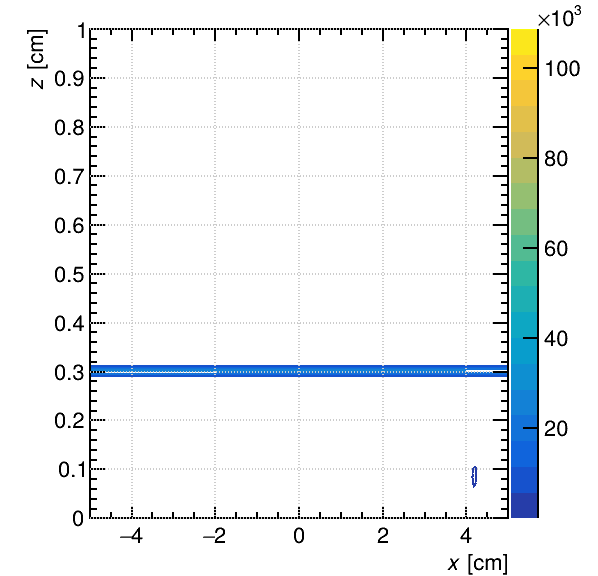Hi, I’m trying so simulate a detector using Garfield++ on my Ubuntu install. The detector I am trying so simulate is an isobutane-filled MWPC, with two planes of wires (one going in x and one going in y directions) separated by a thin sheet of Mylar, which acts as a cathode. I used neBEM crossingWires.C as a basis for my work.
I think I have set up the geometry correctly (I am very new to Garfield, so that’s not a given), but the code takes a very long time to run. If I run the full setup using 12 cores, I have previously waited my entire 8-hour workday for results, and it was still processing. If I leave only a few wires and remove cathode, it runs pretty quick, but if I have either many wires or the Myalr cathode (or both), it slows down a lot.
I can speed up the code by increasing the value in the function nebem.SetTargetElementSize(0.1), but I couldn’t find documentation which explains exactly what the function does, and reading source code was a bit confusing. If I increase the value, the fieldline plots I get are very strange though, they are mostly empty with only some occasional little bits of lines. If I reduce the number of wires though to 5 or less, I can see cocentric circles, as one would expect from an MWPC.
Below are my source code, and also a material file for Mylar, that I created. I also attach a plot for the field shape ion X-Z plane, which the code produces, and which I think looks completely incorrect (this was calculated by setting SetTargetElementSize() to 1).
crossingWires.C:
#include <iostream>
#include <cmath>
#include <vector>
#include <TApplication.h>
#include "Garfield/SolidWire.hh"
#include "Garfield/SolidBox.hh"
#include "Garfield/GeometrySimple.hh"
#include "Garfield/MediumMagboltz.hh"
#include "Garfield/MediumConductor.hh"
#include "Garfield/MediumMylar.hh"
#include "Garfield/ComponentNeBem3d.hh"
#include "Garfield/ViewField.hh"
using namespace Garfield;
int main(int argc, char* argv[]) {
TApplication app("app", &argc, argv);
MediumMagboltz gas("ic4h10", 100.);
gas.SetPressure(5.250432); //7 mbar in torr
gas.SetTemperature(293.15); //Kelvin
gas.EnableThermalMotion(true);
MediumConductor metal;
// Geometry
GeometrySimple geo;
const double radius = 0.003;
const double halflength = 5.;
std::vector< std::vector<SolidWire> > Wires;
Wires.resize(2);
float start_wire_pos = -4.8; //Position in cm of first wire in cm in along +/-5 cm axis
float end_wire_pos = 4.8; //Same as above but last wire
float pitch = 0.2; //Distance between wires in cm
int N_wires = floor((end_wire_pos - start_wire_pos)) / pitch + 1; //Number of wires fitting into that space
std::cout << std::endl << "Processing " << N_wires << " wires along x and y axis each." << std::endl << std::endl;
for(int i = 0; i < N_wires; i++){
float wire_pos = start_wire_pos + (float)i * pitch;
SolidWire wire1(0., wire_pos, 0.3, radius, 2. * halflength, 1, 0, 0);
SolidWire wire2(wire_pos, 0., 0.9, radius, 2. * halflength, 0, 1, 0);
wire1.SetBoundaryPotential(+650.);
wire2.SetBoundaryPotential(+650.);
Wires[0].push_back(wire1);
Wires[1].push_back(wire2);
}
for(int i = 0; i < (int)Wires[0].size(); i++){
geo.AddSolid(&Wires[0][i], &metal);
geo.AddSolid(&Wires[1][i], &metal);
}
MediumMylar mylar;
SolidBox cathode(-5., -5., 0.6, 10., 10., 0.00009);
cathode.SetBoundaryPotential(0.);
geo.SetMedium(&gas);
geo.AddSolid(&cathode, &mylar);
ComponentNeBem3d nebem;
nebem.SetGeometry(&geo);
nebem.SetTargetElementSize(1);
nebem.UseSVDInversion();
nebem.SetNumberOfThreads(12);
nebem.Initialise();
ViewField fieldView1(&nebem);
ViewField fieldView2(&nebem);
ViewField fieldView3(&nebem);
fieldView1.SetArea(-5., -5., 0., 5., 5., 1.);
fieldView2.SetArea(-5., -5., 0., 5., 5., 1.);
fieldView3.SetArea(-5., -5., 0., 5., 5., 1.);
fieldView1.SetPlaneXY();
fieldView1.PlotContour("e");
fieldView2.SetPlaneXZ();
fieldView2.PlotContour("e");
fieldView3.SetPlaneYZ();
fieldView3.PlotContour("e");
gas.WriteGasFile("isobutane.gas");
app.Run(true);
}
MediumMylar.hh:
#ifndef G_MEDIUM_MYLAR_H
#define G_MEDIUM_MYLAR_H
#include "Medium.hh"
namespace Garfield {
class MediumMylar : public Medium {
public:
/// Constructor
MediumMylar();
/// Destructor
virtual ~MediumMylar() {}
bool IsSemiconductor() const override { return false; }
private:
// Band gap energy [eV]
// m_bandGap = ;
// Low-field mobility = ;
};
}
#endif
MediumMylar.cc:
#include <iostream>
#include "Garfield/MediumMylar.hh"
#include "Garfield/GarfieldConstants.hh"
namespace Garfield {
MediumMylar::MediumMylar() : Medium() {
m_className = "MediumMylar";
m_name = "Mylar";
SetTemperature(293.15);
SetDielectricConstant(3.2);
Medium::SetAtomicNumber(6.456261);
Medium::SetAtomicWeight(12.877382343);
Medium::SetMassDensity(1.39);
m_driftable = false;
m_ionisable = true;
m_microscopic = false;
m_w = 78.7; //Mean ionization energy: https://advlabs.aapt.org/bfyiii/files/BFYIIIWorkshop20AlphaParticleSpectroscopyandEnergyLoss.pdf
}
}

